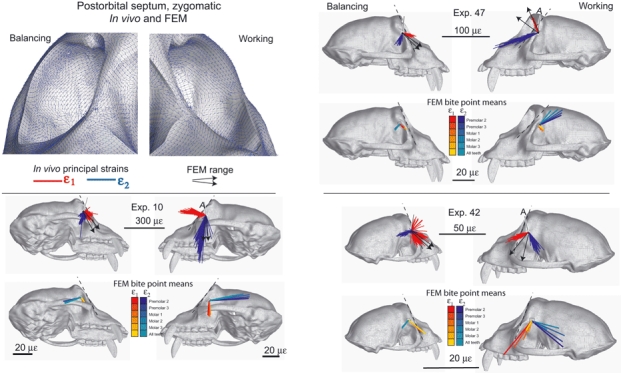Fig. 8.

Strain vector plots of strain data collected from the intraorbital surface of the zygomatic portion of the postorbital septum. Septum data were collected from the right side of the skull, but the working side data are reflected onto the left side to facilitate comparison with the FEM data. The figures in the top left panel show the strain field of maximum principal strain orientations at the centroid of each element. Note that the strain field vectors values were not transformed into the coordinate system of the model surface, which the strain gages sample, whereas the bite point means were appropriately transformed. The remainder of the panels pair figures showing the orientations of the in vivo tensile and compressive strain vectors recorded during experiments 10, 47 and 42 with the in silico data from corresponding ‘gage sites’ on the model. For the in silico data, each line is a vector representing the mean orientation and magnitude of maximum (ε1) (red to yellow) and minimum (ε2) (blue to green) principal strains from all the elements at the gage site. Note that the variance among the vectors from the in silico gage sites is due to variation in bite point, and the variance among vectors from in vivo gage sites is due to variation in magnitude and location of bite force, joint reaction forces and muscle forces. The black arrows on the in vivo plots represent the extremes of the ranges of the mean ε1 orientations from the in silico‘gage sites’. All strain data are presented as seen through the bone of the septum. In vivo strain orientations are presented in Table 2 and in this figure as angles relative to a line following the anterior surface of the postorbital bar in the plane of the orbital aperture.
